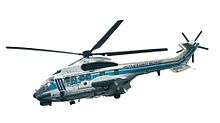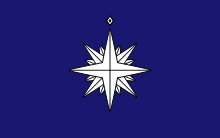Japan Coast Guard
| Japan Coast Guard 海上保安庁 Kaijō Hoan-chō | |
|---|---|
| Abbreviation | JCG |
|
S-Mark | |
|
Japan Coast Guard ensign | |
| Agency overview | |
| Formed |
1948 (As Maritime Safety Agency) April 2000 (As Japan Coast Guard) |
| Preceding agency | Maritime Safety Agency |
| Employees | 13,744[1] |
| Annual budget | 210 601 000 000 yen[1] |
| Legal personality | Governmental: Government agency |
| Jurisdictional structure | |
| National agency (Operations jurisdiction) | Japan |
| Legal jurisdiction | Japanese Maritime Zone |
| Governing body | Japanese Government |
| General nature |
|
| Operational structure | |
| Headquarters | Tokyo, Japan |
| Website | |
| |
| Footnotes | |
| Official Websites in Japanese and English | |

The Japan Coast Guard (海上保安庁 Kaijō Hoan-chō), formerly the Maritime Safety Agency, is the Japanese coast guard. Comprising about 12,000 personnel, it is under the oversight of the Ministry of Land, Infrastructure, Transport and Tourism, and is responsible for the protection of the coastline of Japan. It was founded in 1948.
Overview

The duty of the JCG is to ensure security and safety at sea.This provided through the following services:
- Maritime patrol – patrols Japan's territorial seas and Exclusive Economic Zone (EEZ) of (12–200 nautical miles out from the shore which is approximately 4,470,000 km2).[2]
- Countermeasures against Smuggling and Illegal Immigration
- Countermeasures against Piracy (Regional Cooperation Agreement on Combating Piracy and Armed Robbery against Ships in Asia-ReCAAP)
- Counter Terrorism
- Security against Maritime Conflict – includes the Special Guard Team
- Surveillance of Illegal Operations by Foreign Fishing Vessels
- Countermeasures against Suspicious Vessels and/or Spy Ships
- Dealing with Unlawful Acts by Foreign Oceanographic Research Vessels
- Patrolling and Guarding the Waters near the disputed Senkaku Islands, Takeshima, and the Northern Territories
- Search and rescue
- Hydrographic and oceanographic surveying
- Maritime traffic management
Organization
National Headquarters

The Japan Coast Guard is led by a Commandant and two Vice Commandants. Lower ranking officers include the director general, directors and inspector generals.
Organization (as of April 1, 2009)
- Commandant
- Vice Commandant
- Vice Commandant for Operations
- Administrative Inspector General
- Administration Department
- Coast Guard Research Center
- Equipment and Technology Department
- Guard and Rescue Department
- Hydrographic and Oceanographic Department
- Maritime Traffic Department
- Coast Guard Academy (Kure)
- Coast Guard School (Maizuru)
- Moji Branch school (Kitakyushu)
- Miyagi Branch school (Iwanuma)
The Japan Coast Guard Academy is a 4-year-training institution, located in Kure, Hiroshima prefecture, established within the Coast Guard for the purpose of training students to become officers. Graduates are given a bachelor's degree upon graduation. About 40 cadets graduate from the academy each year.
The JCG maintains two special forces units:
- the Special Security Team (SST) (特殊警備隊 Tokushu Keibi Tai) and
- the Special Rescue Team (SRT) (特殊救難隊 Tokushu Kyūnan Tai).
History
Founded in 1948 as the Maritime Safety Agency of Japan, its English name was changed to Japan Coast Guard in April 2000.[3] In 1950, the Maritime Safety Agency sent minesweepers to the Korean Peninsula under the United Nations flag during the Korean War.
On December 22, 2001, JCG ships intercepted a Chinese-flagged vessel believed to be North Korean in origin, in the Japanese Exclusive Economic Zone between Kyushu and China. When the vessel failed to respond, she was fired upon by the JCG and an exchange of gunfire resulted. The unidentified vessel sank in the Chinese EEZ with all hands.[4] The ship, later salvaged by the JCG, was found to be carrying weapons and spy equipment.[5] The wreck and its contents were put on display at the Japanese Coast Guard Museum at Yokohama.[6]
Operational regions

Headquartered in Tokyo, the JCG has divided the nation into eleven regions to facilitate its coast guard operations. Each region maintains a Regional Coast Guard Headquarters, under which there are various Coast Guard Offices, Coast Guard Stations, Air Stations, Hydrographic Observatory, and Traffic Advisory Service Centers.
- 1st Regional Coast Guard Headquarters: Otaru, Hokkaidō (claim to include southern Kuril islands but never conduct cruise operations under Soviet Union's/Russian presence)
- 2nd Regional Coast Guard Headquarters: Shiogama, Miyagi
- 3rd Regional Coast Guard Headquarters: Yokohama
- 4th Regional Coast Guard Headquarters: Nagoya
- 5th Regional Coast Guard Headquarters: Kobe
- 6th Regional Coast Guard Headquarters: Hiroshima
- 7th Regional Coast Guard Headquarters: Kitakyūshū
- 8th Regional Coast Guard Headquarters: Maizuru, Kyoto
- 9th Regional Coast Guard Headquarters: Niigata, Niigata
- 10th Regional Coast Guard Headquarters: Kagoshima
- 11th Regional Coast Guard Headquarters: Naha, Okinawa
Major equipment


Vessels
The JCG operates 455 watercraft, these include the following:
- Patrol vessels: 121
- Patrol craft: 234
- Special guard and rescue craft: 63
- Hydrographic survey vessels: 13
- Aids to navigation evaluation vessels: 1
- Buoy tenders: 2
- Aids to navigation tenders: 18
- Training boats: 3
Aircraft
The JCG operates 74 aircraft, these include:
- Fixed Wing: 27
- Helicopters: 46
Vehicles
.jpg)
Oddly, JCG uses civilian vehicles known as "Onebox Car(ワンボックスカー)" with JCG Marking instead patrol vehicles.[7]
See also
- Japan Coast Guard Academy
- Japan Coast Guard Museum Kure, Hiroshima Prefecture
- Japan Coast Guard Museum Yokohama, Kanagawa Prefecture
- Umizaru
- Umizaru 2: Test of Trust
- Battle of Amami-Ōshima
- North Pacific Coast Guard Agencies Forum
- DAICHI (ALOS)[8]
References
- 1 2 http://www.kaiho.mlit.go.jp/e/english.pdf
- ↑ http://www.kaiho.mlit.go.jp/e/pamphlet.pdf
- ↑ New Fighting Power! Retrieved on April 25, 2008.
- ↑ 国境を守る海上保安庁. (in Japanese)
- ↑ 北朝鮮 工作船. (in Japanese)
- ↑ 海上保安資料館 横浜館-Japan Coast Guard Museum YOKOHAMA-. (in Japanese)
- ↑ Komine, SST the Japan Coast Guard Special Forces(海上保安庁特殊部隊SST). Namiki Shobo. 2005
- ↑ Advanced Land Observing Satellite "DAICHI" (ALOS) (JAXA webpage)
Books
- Komine, Takao (2005). SST the Japan Coast Guard Special Forces(海上保安庁特殊部隊SST). Namiki Shobo(並木書房). ISBN 4-89063-193-3.
Articles
- "驚愕スクープ 竹島海域調査は「海保(若手官僚)のクーデター」だった!--その時、小泉官邸は蒼ざめ怒声が飛んだ" [Astonishing Scoop - a Research of Area of the Liancourt Rocks was "A Coup Staged by Youngest Members of Japan Coast Guard"! at that moment, Koizumi's Office filled with Sharp-edged Angry shouts]. Weekly Post(週刊ポスト) (in jpn). 38 (21). Shogakukan. 2006-05-19. pp. 20~24.
External links
| Wikimedia Commons has media related to Japan Coast Guard. |
- Official Site (in Japanese)
- Official site (in English)
- JCG Academy Official Site (in Japanese)
- Details of vessels on Thomasphoto (in Japanese)
- Details of vessels on VSPG (in Japanese)
Coordinates: 35°40′33″N 139°45′00″E / 35.67583°N 139.75000°E

